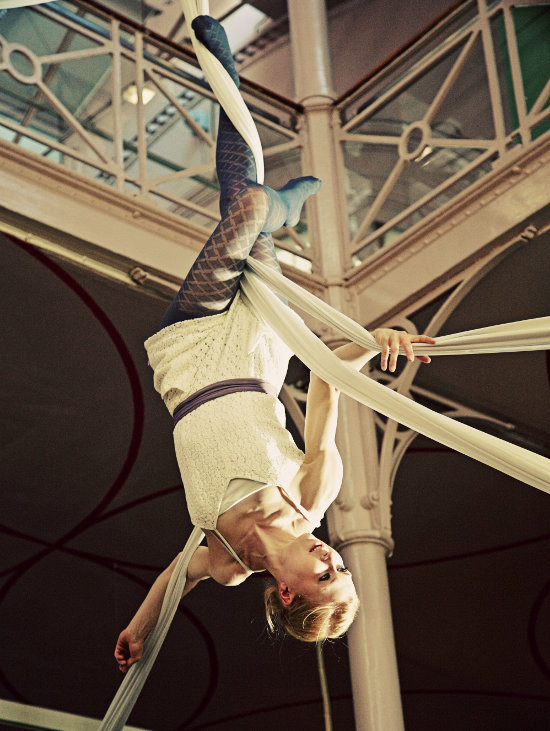
In the far-right corner of the Museum, on the first floor of the unusual double-mezzanine that skirts the entire great hall, a collection of glass cabinets charts the evolution of hobby horses, running from the 1600s (rough-hewn, blocky, Trojan-looking) to the present day (sleek, lacquered, trickster-like, grinning). Two participatory horses are cordoned off with rope, usually active giving rides to visiting children, today the first stop-off for a three-point performance, A Pony is a Small Horse, made and performed by Ilona Jäntti with the performer Alice Allart and musicians Hannah Varty (saxophone) and Jo Keithley (cello). Ilona and Alice ride the horses the way the surrounding young children would perhaps most like to, standing on their backs, balancing upside down, tripping off and on. The vocal audience wants to know, as ever, only two things: how do they do that, and how can we do that?
For the past couple years Ilona has been something like an informal artist in residence at the Museum — she can use the space to practice and rehearse outside of public hours, and in return devises performances pieces that use the eccentricities of the (very eccentric) site. Last year she did a series of short pieces using the Museum sofas, a very large piece of paper, and an aerial hoop; this year the activity is a little bigger, comprising a Pop-up Circus weekend involving a couple other artists.
The Museum is an odd space, a grand Victorian-era hall where the eye can find arresting geometric patterns everywhere — in the metalwork of the balconies, in the even-spaced runway of the suspended strip lighting, in the squared frames of the huge arching windows, and, especially, in the floor itself, covered wall-to-wall by a minute, painstaking mosaic of overlapping black circles which, like several other notable London mosaics, was laid in the 19th Century by women prisoners of Woking Gaol under a hard labour order. There are so many shapes, in fact, that it's easy to miss things in the overload — and the three wooden rings, half-size gymnastic rings suspended now from a balcony, which anywhere else would immediately announce their presence, look themselves innocuously like children's toys. In part 2 of A Pony is a Small Horse, Ilona moves from one to the next, the heights stepped at low, medium, high, in a precise dance choreographed around the business of finding a new position from which to thread a foot or an arm through these three tiny circles of space. Behind her Jo Keithley appears to mime the cello, the acoustics of the Museum being such that a woman playing a string instrument twenty feet away is practically inaudible, but the sound of a cup placed on its cafeteria saucer carries across a furlong's space.
The final part of the performance is sited at the entrance of the Museum, where four lengths of white silk hang down from a single rigging point, and from there separate and flow outwards to be tied off on the surrounding Museum pillars. You could perhaps picture it by imagining a maypole, but the important thing about the set-up is that it's got layers of asymmetry: the silks are all tied in different directions, lie at different heights, and have different levels of slack. Ilona performs somewhere at the centre of all these variables, moving with the centre, playing with tension and friction and stored rotation. As one unpredictable movement path connects fluidly to the next, you have perhaps the feeling that you are watching a magician: someone who can open space to escape constraint.
Through the day, and in fact the weekend, A Pony is a Small Horse is repeated, and joined by a series of short site-specific pieces by the juggler Frederike (one of which is performed dissonantly under a bold-face infographic display about youth knife crime) and by a durational performance, Knit, in which Aino Ihanainen interleaves the complimentary (?) disciplines of knitting and handbalancing, the Museum around her gradually becoming covered with wool and giving the impression that the rope cordon has been established for no other reason than to contain her handicraft's steady outward creep.